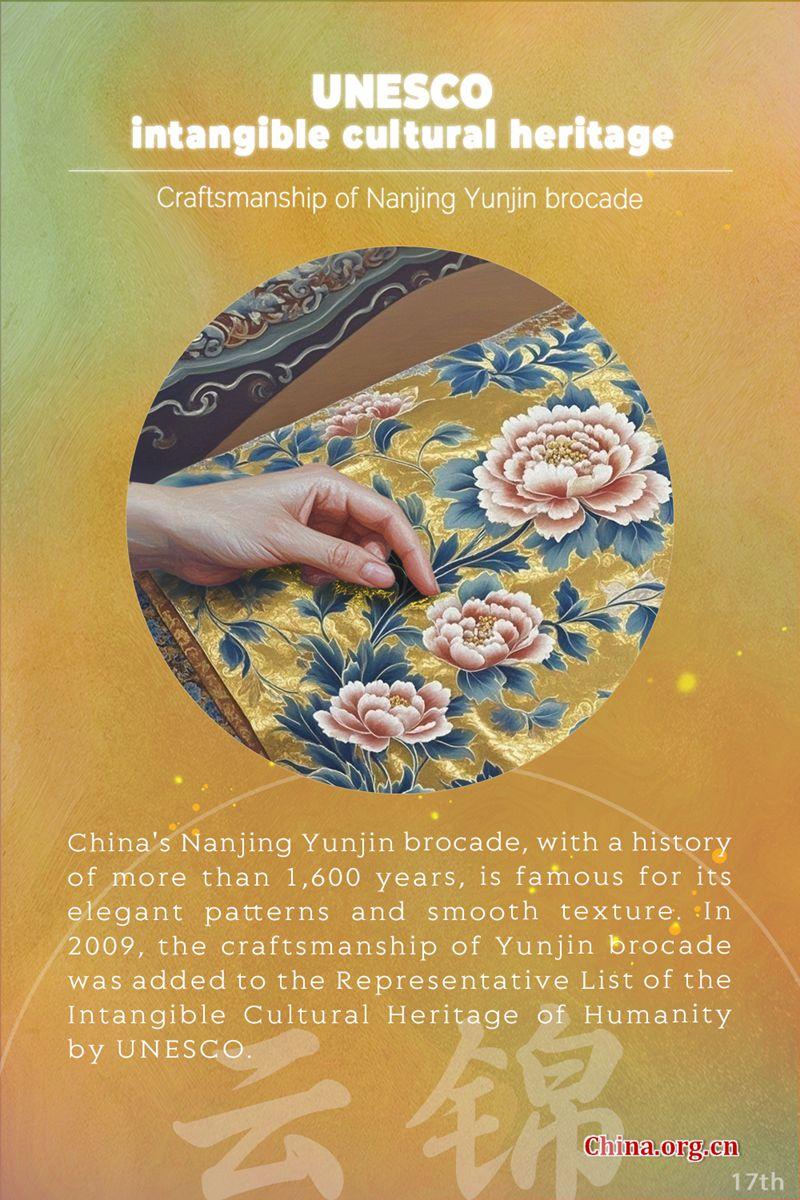
 0 Comment(s)
0 Comment(s) Print
Print E-mail China.org.cn, September 12, 2024
E-mail China.org.cn, September 12, 2024Editor's note: China's Nanjing Yunjin brocade, with a history of more than 1,600 years, is famous for its elegant patterns and smooth texture. In 2009, the craftsmanship of Yunjin brocade was added to the Representative List of the Intangible Cultural Heritage of Humanity by UNESCO.

Between the 17th and 18th centuries, a large family in China rapidly accumulated great power and wealth for three generations. They had a close relationship with the imperial family and earned enormous fortune through running a royal brocade business.
However, the influential family, surnamed Cao, eventually saw their good fortune take a turn for the worse, losing everything. This story, both the rise and fall of the Cao family, was thought to be the inspiration behind the novel "Dream of the Red Chamber," one of the four great classics in Chinese literature. Written by Cao Xueqin (1715-1763), the esteemed novel is based on the author's own life.
The Cao family lived in ancient Nanjing, the capital city of today's Jiangsu province in east China, where exquisite Nanjing Yunjin brocade prospered. Cao Xueqin's great grandfather, Cao Xi (around 1629-1684), was the commissioner of imperial textiles in Jiangning (today's Nanjing). Cao Xueqin's grandfather, Cao Yin (1658-1712), was a childhood playmate to Emperor Kangxi (1654-1722) who reigned during the Qing Dynasty (1644-1911). Moreover, Cao Yin's mother, Lady Sun, was Emperor Kangxi's wet nurse.
Owing to a close relationship with the emperor and starting with Cao Xi, the patriarch of the Cao family was consecutively named for three generations the commissioner of imperial textiles in Jiangning. The commissioner of imperial textiles was responsible for the lucrative textile business. Members of the Cao family became experts on fabrics, including Cao Xueqin.
During the time that the Cao family was reaping the rewards of their affluence, the manufacturing of Nanjing Yunjin brocade was also at a high peak with its development. In "Dream of the Red Chamber," Cao Xueqin carefully describes the delicacy of this quality silk textile. Since then, Nanjing Yunjin brocade has been studied by numerous enthusiasts in both China and abroad.
Nanjing Yunjin brocade was both the finest fabric during the three generations of the Cao family's time and during the Ming (1368-1644) and Qing (1644-1911) dynasties. A silk of splendor, it was once reserved to only be used by the royal family, with it occasionally being gifted or rewarded to high-ranking officials by the emperor.
"Yun" in Yunjin means "cloud," and "jin" denotes "brocade." Ancient Chinese gave Yunjin brocade this name because they thought this silk handicraft looked like colorful clouds. This special feature, which is still highly valued today, is achieved by means of unique weaving techniques.
Traditionally, the production of Yunjin brocade required two craftspeople to operate a large wooden loom in order to weave silk strings into textiles. One of these craftspeople would sit at the upper part of the loom, pulling strings and meticulously defining patterns. The other craftsperson, or the weaver, would sit at the lower part of the loom and weave the silk threads into textiles. This process involved a traditional weaving skill called "tongjing duanwei," which means "weaving by extending the warp threads while splitting the weft ones." Besides using silk threads, weavers would also add fine materials, such as gold and silver yarns as well as peacock feathers, into the textiles they were creating.
The history of Nanjing Yunjin brocade can be traced back to the Eastern Jin Dynasty (317-420), and this silk's industry reached its peak during the reign of Emperor Qianlong (1711-1799) in the Qing Dynasty. During this time of high prosperity for the industry, around 300,000 people worked in the Yunjin brocade sector with more than 30,000 looms in Nanjing. A city of about 900,000 people at that time, one third of Nanjing's population worked in the Yunjin brocade industry.
Today, Nanjing Yunjin brocade remains famous for its exquisite techniques, elegant patterns and smooth texture. It is now often used to make high-end attire and souvenirs. Requiring skilled artisans to do over a hundred steps to produce only a few centimeters of textile a day, Yunjin brocade's complex production methods have been adopted to replicate ancient silk fabrics in an effort to protect cultural relics. Well-preserved Yunjin brocade from the past have also helped researchers take a deeper look into the history of Chinese silk textiles. In 2009, the craftsmanship of Yunjin brocade was added to the Representative List of the Intangible Cultural Heritage of Humanity by UNESCO.
Discover more treasures from China on UNESCO's ICH list:
• 2022: Traditional tea processing
• 2020: Wangchuan ceremony, Taijiquan
• 2018: Lum medicinal bathing of Sowa Rigpa
• 2016: Twenty-four solar terms
• 2013: Abacus-based Zhusuan
• 2012: Training plan for Fujian puppetry performers
• 2011: Shadow puppetry, Yimakan storytelling
• 2010: Peking opera, acupuncture and moxibustion, wooden movable-type printing, watertight-bulkhead technology of Chinese junks, Meshrep
• 2009: Yueju opera, Xi'an wind and percussion ensemble, traditional handicrafts of making Xuan paper, traditional firing techniques of Longquan celadon, Tibetan opera, sericulture and silk craftsmanship, Regong arts, Nanyin, Khoomei, Mazu belief and customs, Dragon Boat Festival, Manas, Craftsmanship of Nanjing Yunjin brocade

Go to Forum >>0 Comment(s)